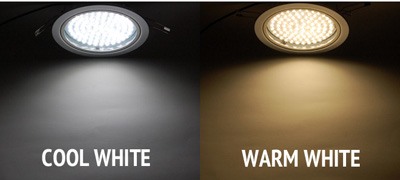Customers who are new to LED technology don’t realise that LED light bulbs come in different variations of “white”.
With traditional incandescent or halogen bulbs you could not choose the colour of the light that the bulb produced as this was down to pure physics. Traditional bulbs work by passing electricity through a wire that glows hot. This glow produces the light seen. As LED light bulbs are a completely different technology and much more technically advanced it is possible to choose the colour of the light that you want.
The colour temperature of light can be measured as a number on the Kelvin scale. This is represented by a number followed by the symbol “K”. High colour temperatures of over 5000K are said to be cool colours and often have a blue tone to them. Whereas low colour temperatures of 2,500 – 3,200 are said to be warm colours and have yellow or orangey tones to them.
A few examples of the difference in Kelvin are as follows:
A candle flame has a Kelvin value of 1,850K
Traditional Incandescent lights have a Kelvin value of between 2,700K – 3,300K
Moonlight has a Kelvin value of 4,100K
On an overcast day, the light would be around 6,500K
With LED light bulbs there are usually two options of white colour available and they are normally referred to as warm white or cool white. warm white is usually around 3000K and cool white around 5000-6000K. When choosing your bulbs you should check the Kelvin value of the bulb.
In domestic lighting, 75 – 80% of customers buy warm white LED light bulbs as they offer the closest match to their old incandescent or halogen bulbs that they are replacing. The light given off by a warm white LED bulb can be described as soft and warm with a slight yellow hint to it.
Some customers purchase cool white LED light bulbs if they want the brightest light possible or if they want to achieve a modern look to a room. This particularly suits colour schemes that are bright and bold and use primary colours, or even colour schemes that are predominantly white where a clean minimal look is required.
It’s also possible to use both warm and cool white bulbs in the same room on different switches to give different options on how the room will look. For example in a kitchen you may want warm white bulbs in the ceiling for everyday use but also have under unit lighting in cool white in order to give a very different effect at night once the main lights are off.
In commercial lighting the majority of customers opt for cool white bulbs. These give a brighter light but you should be careful to ensure that the colour temperature is not too high, or in practical terms the light not too cool, otherwise the effect may seem very harsh or displeasing to the eye.
Remember that if you have any questions please feel free to give us a call on: 0845 459 8010.




